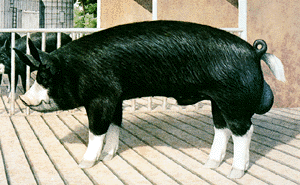Berkshire Swine
 Three hundred years ago - so legend has it - the Berkshire hog was discovered by Oliver
Cromwell's army, in winter quarters at Reading, the county seat of the shire of Berks
in England. After the war, these veterans carried the news to the outside world of
the wonderful hogs of Berks; larger than any other swine of that time and producing
hams and bacon of rare quality and flavor. This is said to have been the beginning
of the fame of the Reading Fair as a market place for pork products.
Three hundred years ago - so legend has it - the Berkshire hog was discovered by Oliver
Cromwell's army, in winter quarters at Reading, the county seat of the shire of Berks
in England. After the war, these veterans carried the news to the outside world of
the wonderful hogs of Berks; larger than any other swine of that time and producing
hams and bacon of rare quality and flavor. This is said to have been the beginning
of the fame of the Reading Fair as a market place for pork products.
This original Berkshire was a reddish or sandy colored hog, sometimes spotted. This would account for the sandy hair still sometimes seen in the white areas of some modern Berkshires. Later this basic stock was refined with a cross of Siamese and Chinese blood, bringing the color pattern we see today along with the quality of more efficient gains. This was the only outside blood that has gone into the Berkshire breed within the time of recorded livestock history. For 200 years now the Berkshire bloodstream has been pure, as far as the records are known today.
The excellent carcass quality of the Berkshire hog made him an early favorite with the upper class of English farmers. For years the Royal Family kept a large Berkshire herd at Windsor Castle. A famous Berkshire of a century ago was named Windsor Castle, having been farrowed and raised within sight of the towers of the royal residence. This boar was imported to this country in 1841, creating a stir in the rural press which has seldom been equaled. From these writings, it appears that he must have weighed around 1,000 pounds at maturity. His offspring were praised for their increased size, along with their ability to finish at any age.
According to the best available records, the first Berkshires were brought to this country in 1823. They were quickly absorbed into the general hog population because of the marked improvement they created when crossed with common stock. At least one of the major "American" breeds has publicly admitted its debt to Berkshire blood in establishing its foundation. This breed carries identical color markings.
In 1875, a group of Berkshire breeders and importers met in Springfield, Illinois, to establish a way of keeping the Berkshire breed pure. These agricultural leaders of the day felt the Berkshire should stay pure for improvement of swine already present in the United States and not let it become only a portion of the "Common Hog" of the day. On February 25 of the same year, the American Berkshire Association was founded, becoming the first Swine Registry to be established in the world. This society drew forth an enthusiastic response from men working with the breed both in this country and in England. The first hog ever recorded was the boar, Ace of Spades, bred by Queen Victoria.
At that time most of the leading herds in this country were using some imported stock. Therefore, it was agreed upon when the society was established, that only hogs directly imported from established English herds, or hogs tracing directly back to such imported animals, would be accepted for registration. The breed today is descended from these animals recorded at the time or from stock later imported.
The home of the American Berkshire Association is West Lafayette, Indiana. Here, a bedford stone building carries the records and registry of the most influential breed of swine in the history of the world.
The Berkshire Breed paved the way for better swine production and improvement in the United States and Europe, as well. Berkshires have had great influence upon the swine industry the past 100 years, and the Breed Association has made people aware of the importance of purebred animals. Types have changed in the swine industry due to economic needs, and Berkshires have played some of the most distinguishable roles in the Swine Industry. In the 1940's and early 1950's, Berkshires set a pace in market hog shows never to be surpassed - during this era, Berkshires won more consecutive Chicago International Truckload Championships than any other breed. Their winnings have never been duplicated.
During the past several years the Berkshire has made great strides of improvement towards meeting the demands of the swine industry. Selection pressure has been applied toward those traits of great economical importance - fast and efficient growth, reproductive efficiency cleanness, and meatiness.
This is the background of the modern Berkshire hog. It is important because it explains why the Berkshire is such a true breed when crossed on other breeds or on common hogs. His characteristics have been established and purified over a very long period of time. Breeders have been working at the task of improving him as far back as any record goes. He is indeed a splendid example of an improved breed of livestock.
Content Providers
American Berkshire Association, 1769 US 52 West, PO Box 2436, West Lafayette, Indiana 47906 Phone: (317) 497-3618
National Pork Producers Council, P.O. Box 10383, Des Moines, Iowa 50306
